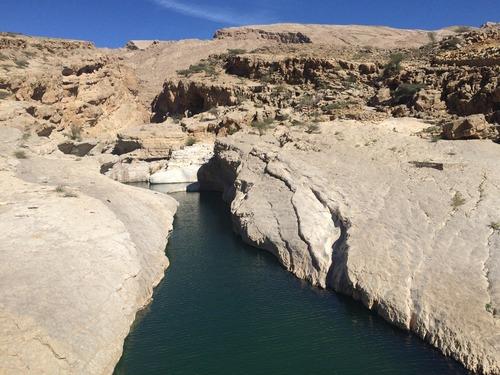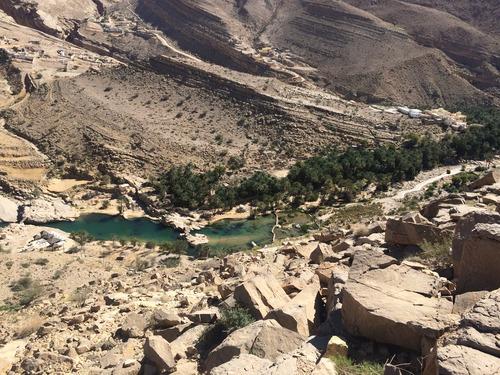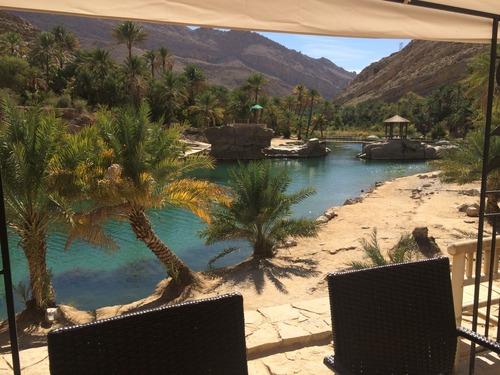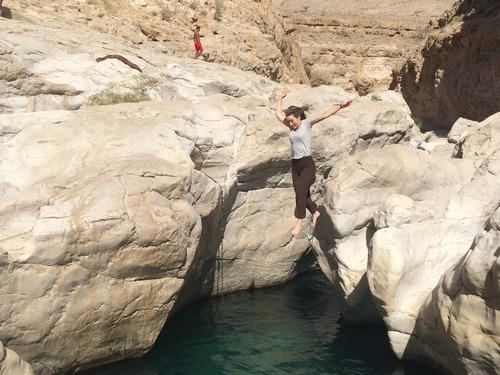The French novelist Antoine de Saint-Exupéry once said, “What makes the desert beautiful is that somewhere it hides a well.”
Nowhere is this statement more apt than in Oman. The land of Sinbad the Sailor and the Queen of Sheba, Oman — with the exception of the coastline — is seemingly a never-ending desert. In the western part of the country is the Empty Quarter, with sand dunes that tower 30 stories high. The rest of the country is a rocky desert, covered in limestone and fossilized rock.
Related: The Ancient, Secret City of Bagan — the Most Zen Place in the World

The dramatic landscape of Oman. (Photo: Kristina Cafarella)
To the untrained eye, it is a barren, lonely landscape that looks as if it would not — could not — support life. But then, just as the desert becomes monotonous and unforgiving, you climb to a mountaintop, look down, and see trees, greenery, and water.
The temperature was hovering at around 90 degrees while I was driving through the Sharqiyah region, 230 kilometers north of the capital city, Muscat. The car was air-conditioned, but when we got out to hike, my lungs felt as if they were full of sand, gravel, and dust.
I soon sat down to drink some water and rest for a minute, when my guide, Qais, said, “Look over your shoulder.” And there it was — the Wadi Bani Khalid, one of the most famous oases in Oman (wadi means valley and in the valleys are oasis).
For a hot second, I could imagine what the Bedouin felt like when they saw this oasis hundreds of years ago — riding by camel for days – hot, tired, and thirsty — and then finding a slice of heaven hidden on earth.
Related: The Live “Stock” Market of Oman

The dramatic landscape of Wadi Bani Khalid. (Photo: Kristina Cafarella)
The streams and pools of the Wadi Bani Khalid are surrounded by date palms and greenery. They were so clear that, from the position I sat in, at least a mile up, I could see through to the bottom of the pools.“Let’s go. Now,” I said.
“Absolutely,” Qais agreed. Five minutes later (by car), I was walking though a biblical scene. Because Oman used to be covered by ocean, the limestone boulders are etched with fossils. You have to watch your step, since it is slippery, and the holes in the rock are magically filled with water.
“Where does this come from?” I asked
“Underground,” Qais said
“Yes, but it’s a solid rock pool. How does it seep in?” I asked, mesmerized.
Qais shrugged. “It just does.”
“It’s like Mars,” I said. “Seriously, it looks as if we’re in a photo from the Mars Rover.”
Related: Welcome to Oman — the 2015 ‘It’ Destination

In the restaurant by the main pool at Wadi Bani Khalid. (Photo: Kristina Cafarella)
The main pool has a restaurant set up by an enterprising local (the food is passable — bring your own if you can). The best part of the oasis is a bit of a hike. Set off down the main path and trek about 20 minutes, and you will arrive at deep bathing pools. For the adventurous, keep walking along the dry riverbed (which fills several times a year), until you reach the Kahf Maqal, the underground caves.

Cooling off. (Photo: Kristina Cafarella)
This is a spelunker’s dream, but also very dangerous, as the caves can be filled with water, and the entryways are crumbling. Historically, these caves have been hideouts for bandits, travelers, and even kings, who waited out attacks from invaders. If you are a woman, do not go alone, and cover up while swimming. There are some tourists who will strip down to their bikinis, but remember: Even though Oman is an open country now, it is still a conservative Muslim area. If you strip to a bathing suit, it’s akin to posing for Playboy, and you will attract a huge (male) crowd and a lot of unwanted attention. Swim in a shirt and loose pants. It’s just as fun, and way more comfortable than feeling like a playmate in a zoo. Trust.
Thanks to Mountain Travel Sobek for putting this trip together.
